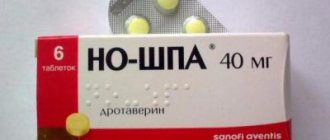Ulcer and antibiotics - when is their use justified?
Inflammatory processes in the stomach can occur in acute or chronic form. In the absence of proper treatment, these phenomena can provoke complications and cause serious harm to the human body.
Treatment of such pathologies is usually carried out with medications. The main goal of therapy is to eliminate the root cause that caused the development of the disease.
In cases where the development of the inflammatory process is caused by the activity of the pathogenic microorganism Helicobacter pylori, the course of treatment must necessarily include the use of antibacterial drugs. That is why doctors prescribe Metronidazole for gastritis and ulcers , because this particular drug works quite effectively and is safe for humans.
Treatment regimen for ulcers with antibiotics
In the treatment of gastritis and ulcers, a treatment regimen can be prescribed, consisting of several two stages:
- Treatment of gastritis and stomach ulcers with Metronidazole and Clarithromycin in combination with inhibitors. This therapy is used to suppress the vital activity of Helicobacter pylori in the patient’s body. In this case, the dosage of Metronidazole for stomach ulcers in the fight against Helicobacter pylori infection is calculated taking into account the individual characteristics of the clinical picture of the disease. If adverse reactions to basic medications occur, doctors can prescribe their analogues;
- Based on the results of the interim examination, the course of treatment with Metronidazole for duodenal ulcers or gastritis can be continued. However, instead of Clarithromycin, antibiotics of the tetracycline group should be taken at the second stage of therapy. The result of treatment should be the complete absence of pathogenic microorganisms in the human digestive system.
Antibacterial drugs used in the treatment of Helicobacter pylori infection complement each other. Bismuth, Omeprazole and the antihistamine Ranitadine are prescribed together with antibiotics. To obtain the expected therapeutic effect, antispasmodics, painkillers and healing drugs can be additionally prescribed. Traditional medicine may be recommended as additional therapy.
Two-stage treatment regimen
The treatment regimen for stomach ulcers is selected by the doctor individually.
Most often it consists of two stages:
- In the first, which lasts a week, treatment is carried out with two antibiotics, usually this complex of clarithromycin and metronidazole. Lansoprazole, which belongs to the PPI group, may also be prescribed. The dosage is determined by the doctor based on the individual characteristics of each patient.
All this is done to solve the main task of the first stage - the elimination of Helicobacter pylori. It is almost impossible to achieve complete destruction of Helicobacter (there are several types). Dying in the stomach, the pathogenic microbe descends lower into the intestines, causing inflammation. Re-infection through shared utensils and during fibrogastroduodenoscopy (FGDS) is also possible.
- The duration of the second stage is two weeks, during which the destruction of Helicobacter continues. For this, a complex of tetracycline and metronidazole is used. For auxiliary therapy, bismuth-containing drugs are used, Famotidine and Ranitidine from the BHR group, Rabeprazole, Omeprazole from the PPI group.
Auxiliary therapy is carried out using various groups of medications to relieve unpleasant symptoms of the disease and speed up the recovery process.
Metronidazole for peptic ulcers
Standard regimens for the treatment of gastric and duodenal ulcers with Metronidazole involve oral administration of tablets. In severe cases of the disease, intravenous administration of the drug is also possible.
Treatment is carried out for two weeks. Regardless of taking other medications, it is usually recommended to take 2 tablets of Metronidazole 500 mg three times a day. At this dosage, the medicine penetrates well into the foci of inflammation and has optimal therapeutic activity. If necessary, treatment with Metronidazole is repeated after a week's break.
However, Metronidazole cannot be prescribed independently for stomach ulcers . Therapeutic therapy, as well as the calculation of dosages of medications, can only be carried out by a specialist. Otherwise, when self-medicating gastritis and ulcers, the patient’s condition may worsen (vomiting, internal bleeding and acute pain).
Sources:
Vidal : https://www.vidal.ru/drugs/metronidazole__18699 GRLS : https://grls.rosminzdrav.ru/Grls_View_v2.aspx?routingGu >
Found a mistake? Select it and press Ctrl + Enter
For what diseases is it indicated and how to take it
Metronidazole is prescribed for the treatment of strains of infections that are sensitive to the active substance of the drug. In order to prevent the development of pathogen resistance to the drug, it is prescribed only based on the results of a microbiological study. Metronidazole may be prescribed to treat the following conditions.
Acute intestinal amoebiasis
The development of the disease is caused by histolytic amoeba (Entamoeba histolytica). Causes the formation of ulcers in the large intestine. Pathological changes are provoked by the tissue form of the pathogen.
Through the blood, the parasite is able to enter the lungs, liver, pancreas and brain, causing abscesses in them.
If the pathological process has invaded the liver, treatment with metronidazole may require removal of purulent discharge from the organ.
How to treat:
The course of treatment with metronidazole can be up to 10 days. The drug is taken three times a day (in total - no more than 1.5 g of the drug). The maximum daily dose for the acute form of the disease is 2.25 g. The duration of use and the total volume are strictly controlled by the attending physician.
Trichomoniasis
Disruption of the genitourinary system causes trichomoniasis. The causative agent is Trichomonas vaginalis, which is transmitted sexually. In a chronic course, the disease causes the development of prostatitis, cervical erosions, causes infertility, and in pregnant women increases the risk of disruption of the normal course of pregnancy.
How to treat:
Metronidazole is prescribed in this case after confirming the presence of the pathogen in the patient’s body by taking a smear or testing a culture. If confirmed, the course of treatment is recommended for the sexual partner as well. Spouses usually undergo treatment at the same time to avoid re-infection.
The standard course of treatment is 10 days. The drug is taken twice a day, 250 mg. The second option is 400 mg of the drug twice a day for 5 days. Based on the results of the control examination, the course can be re-prescribed (not earlier than in a month). The attending physician prescribes the drug regimen for each spouse on an individual basis.
Women can additionally be prescribed metronidazole in the form of vaginal suppositories and tablets. The course of treatment should be continued upon the onset of menstruation.
Giardiasis
Parasites affect the upper parts of the small intestine (also the duodenum), destroy the mucous membrane, provoke inflammation and tissue atrophy. They provoke the development of dysbacteriosis and biliary dyskinesia.
They enter the body if hygiene rules are not followed, through food (insufficiently washed and heat-treated), and drinking water.
How to treat:
When treating a disease that consists of three successive stages, metronidazole begins to be used in the second, that is, two weeks after the start of treatment. The drug is taken 400-500 mg three times a day. The duration of the course can be from 5 to 7 days. Treatment with the drug is always prescribed individually by the attending physician.
At the end of the course of treatment, if symptoms persist, a stool test should be taken a month later (the test is repeated three times with an interval of several days).
It has been noted that in some patients, after using Metronidazole for the treatment of giardiasis (while its results are positive), lactose intolerance may persist for some time and the symptoms will resemble those characteristic of giardiasis.
Metronidazole for the stomach
Metronidazole is used as part of complex treatment for gastritis. This pharmaceutical drug has a wide spectrum of action, which also applies to pathologies of the digestive system. "Metronidazole" with a pronounced antibacterial effect helps relieve inflammation from the affected gastric mucosa and cleanse it of pathogenic microorganisms that destroy the walls of the digestive organ.
Release form, composition and mechanism of operation
The drug is sold in the form of a powder from which a liquid for intravenous administration is prepared, a solution for infusion, a suspension, tablets for oral administration, and also in the form of vaginal pills. The main component of the drug is metronidazole, which has a pronounced antibacterial, antiprotozoal and antimicrobial effect. Metronidazole has a detrimental effect on pathogenic microorganisms, disrupting their respiratory processes and causing cell death. When taken orally, the drug substances are quickly and completely absorbed from the gastrointestinal tract, reaching its maximum concentration after 1-3 hours.
Indications
It is important to take the drug "Metronidazole" as an adjuvant in the treatment of pathological conditions such as:
- inflammation of the inner lining of the heart;
- infectious damage to the abdominal organs and lungs caused by aerobic bacteria;
- infectious inflammation of all components of bone tissue;
- urethritis and vaginitis;
- giardiasis;
- chronic tonsillitis;
- peritonitis;
- abscesses of soft and bone tissue structures.
The drug copes with helicobacteriosis, which provokes stomach ulcers.
Metronidazole is often prescribed to prevent the development of complications after surgery. In addition, the medication is used to treat gastritis, and in combination with other medications, it is used to treat gastric ulcers caused by the active activity of the Helicobacter pylori bacterium.
Three-component treatment regimen
If a stomach ulcer develops against a background of high acidity, antibiotics, antacids and PPIs are used as components of a three-step treatment regimen:
- Antibacterial compounds such as Tetracycline and Amoxicillin are used as the first component.
- The second component is Tinidazole.
- And third: medications containing bismuth and compounds from the PPI group.
For auxiliary therapy, probiotics, prokinetics, antispasmodics, antidepressants, as well as sedatives that normalize the emotional sphere are prescribed.
How to use?
Before using Metronidazole as part of a complex treatment of stomach diseases, it is important to consult a specialized physician who will prescribe a therapeutic course individually for each patient.
For adults and children over 16 years of age, the dosage is 1-2 tablets per day, which should be taken after a meal with a large volume of water. You are allowed to consume no more than 6 pieces per day. The duration of the treatment course is 7-10 days, depending on the severity of the inflammatory process occurring on the walls of the organ. You need to drink Metronidazole for stomach ulcers in combination with an antibiotic such as Amoxicillin in a dosage of 2 tablets. three times a day. The duration of treatment usually takes up to 14 days.
Instructions for use of the drug metronidazole
Inside, with a glass of water.
The daily dose is divided into 3 doses for adults, and 2 doses for children 6-15 years old. For trichomoniasis infection, 2 treatment regimens are used: 2 g of the drug once or 0.250 g twice a day, course 10 days.
When Helicobacter pylori is irradiated, metronidazole is combined with penicillin antibacterial drugs to suppress drug resistance. The daily dose of metronidazole is 1.5 g.
Metronidazole in the treatment of intestinal amebiasis is used in a daily dose of 1.5 g.
For acute amoebiasis, the daily dose is 2.250 g. The daily dose for children is 0.5 g.
Treatment of extraintestinal forms of amebiasis requires combination with tetracycline antibacterial drugs. The daily dose of metronidazole is 2.5 g in adults and 0.5 g in children.
Prevention of complications after surgical interventions involves taking 0.750 - 1.5 g of the drug per day for 4 days before surgery and 0.750 in the postoperative period for a week.
Contraindications and adverse reactions
Not everyone is allowed to use Metronidazole for the treatment of stomach diseases. The medicine should not be used by patients with hypersensitivity to its components, pregnant or nursing mothers. The drug is contraindicated in patients who have been diagnosed with severe pathologies of the central nervous system, as well as those who have been diagnosed with acute liver or kidney failure. In addition, a contraindication to the use of Metronidazole is a pathological condition, which is characterized by a reduced number of leukocytes in the blood.
In most cases, the drug is well tolerated, but if it is abused, side symptoms will not take long to appear. And then the patient may face such undesirable consequences as:
- flatulence, frequent loose stools;
- severe itching of the skin, urticaria;
- increased body temperature;
- pain in the temples and back of the head, dizziness;
- urinary disturbance;
- dry mouth.
Return to contents
Metronidazole
The drug belongs to the category of antiprotozoal agents and antimicrobial drugs with a wide spectrum of action. The antibiotic is obtained synthetically. The mechanism of antibacterial action is to block the tissue respiration of microbes: the production of proteins in the cells stops, and the bacterium dies.
The daily dosage for gastric ulcer is given within 1000 mg. Taking metronidazole tablets does not depend on food intake. The duration of the therapeutic course is 2 weeks. According to the available instructions for use, metronidazole has a number of contraindications. First of all, leukopenia is a decrease in the number of leukocytes in the blood, organic diseases of the central nervous system. In addition, an absolute contraindication to the prescription of metronidazole is increased individual sensitivity to the components of the drug.
The drug Metronidazole
In the first trimester of pregnancy, during lactation, metronidazole is not prescribed. In subsequent trimesters, the drug is used extremely carefully. Contraindications include insufficiency of liver or kidney function.
Compatibility
It should be able to enhance the effect of indirect anticoagulants, and this is fraught with an increase in the time of prothrombin formation, therefore, with such a tandem, there is a need to adjust the dose of the anticoagulant. In addition, when using an antimicrobial drug simultaneously with Disulfiram, the risk of developing various neurological symptoms increases. Therefore, it is important to maintain an interval between doses of these medications, and it is better if it is more than 2 weeks.
The drug cannot be combined with alcoholic drinks.
There is an increase in the antimicrobial effect of Metronidazole when it interacts with sulfonamides. While undergoing treatment with the antibacterial drug in question, you should not drink alcohol, as this is dangerous due to the occurrence of abdominal pain, nausea, severe headaches and skin flushing.
Stomach ulcer: how to treat it
Every second inhabitant of the planet is a carrier of a dangerous bacterium that causes stomach ulcers. Fortunately, modern methods of therapy can cure ulcers at any stage.
Why suddenly?
Peptic ulcer
- not a random “acquisition”. According to research, in 75% of cases, a defect in the gastric mucosa is formed as a result of Helicobacter pylori infection. This spiral-shaped bacterium thrives in the acidic environment of the stomach and provokes inflammatory processes. Almost half of humanity is infected with it, but for the vast majority the infection does not cause any trouble. Only 20% of them will experience all the insidiousness of Helicobacter on their body.
Another common cause of peptic ulcers is the use of nonsteroidal anti-inflammatory drugs (NSAIDs). They disrupt the permeability of the barrier of the gastric mucosa, which becomes defenseless against the damaging effects of hydrochloric acid. According to statistics, almost 30% of people forced to take aspirin, ibuprofen, nimesulide, diclofenac and other NSAIDs for a long time become victims of stomach ulcers.
Smoking, stress or depression, anemia and some other less significant factors play a certain role in the development of the disease.
Eradication from the word “eradication”
It is much easier to ask the nearest pharmacy for a medicine for stomach pain, but it is unlikely to help you if you have an ulcer. Therefore, the first thing you need to do is go to the doctor. Moreover, the treatment regimen for peptic ulcer disease directly depends on its underlying causes. Immediately after the diagnosis is made or during gastroscopy, which depicts the picture of gastric ulceration, a test for Helicobacter pylori is performed. If the results confirm infection - and most likely they do - the patient is indicated for eradication therapy. Otherwise, treatment for ulcers consists only of blocking the production of hydrochloric acid.
The name “eradication” itself provides a comprehensive description of the method: eradication is translated from English as “eradication”. The first, simplest eradication therapy scheme was proposed by the discoverers of Helicobacter pylori, Australians John Warren and Barry Marshall in the 80s of the last century. It included only two drugs: bismuth salt and metronidazole. A little later, triple and then quadruple therapy for peptic ulcer disease appeared. They became the “gold standard” in her treatment.
Medicines for the treatment of stomach ulcers: what and why?
The eradication therapy regimen contains drugs of two or three pharmacological groups.
- Proton pump inhibitors (PPIs).
They quickly and very effectively suppress the secretion of hydrochloric acid. Within 12 hours after taking the medicine, the pH in the stomach is guaranteed not to fall below 4. This is quite enough to create favorable conditions that allow the mucous membrane to begin restoration work. Proton pump inhibitors include omeprazole (Omez), lansoprozole (Epicure), pantoprozole (Controloc), rabeprazole (Pariet), and esomeprazole (Nexium). Despite the noticeable difference in price between some representatives of the group, they are all considered to be equally effective. - Antibiotics.
Antibacterial drugs are the basis of eradication therapy. The clever bacterium, which can survive in highly acidic conditions, is treated with only a few drugs. Among them are amoxicillin (Flemoxin Solutab), tetracycline and clatrithromycin (Klacid). Due to the widespread use of eradication therapy, doctors in recent years have begun to notice an increase in strains of Helicobacter pylori infection resistant to clarithromycin. If the infection is classified as particularly “malignant” and does not respond to standard therapy, levofloxacin may be added to the treatment regimen. - Antimicrobial drugs.
Medicines with antimicrobial properties, unlike antibiotics, are active against not only bacteria, but also some other microorganisms, in particular protozoa. Two drugs are used as antimicrobial agents: metronidazole and ornidazole. They destroy the helical structure of the bacteria's DNA, and it dies. - Bismuth preparations.
Bismuth has a bactericidal effect by disrupting the integrity of the cell wall of Helicobacter pylori. The traditional bismuth preparation, to which there has been no alternative for several decades, is bismuth tripotassium dicitrate (De-Nol).
Treatment with antibiotics
To treat peptic ulcer with conservative methods, two regimens are used, each including an antibacterial component, an antacid and an anesthetic.
Scheme 1
The first therapeutic regimen for duodenal ulcers involves the use of an antibacterial drug of only one type and chemical group in combination with an antacid drug.
These substances are interchangeable in terms of their pharmacological effect. The active substance of the drugs has similar therapeutic effects.
To treat peptic ulcers, any of the above drugs is used orally three times a day. The individual dosage will be selected by the treating gastroenterologist, taking into account the age, body weight and physical condition of the patient.
The average therapeutic dose is 500 mg for an adult patient, 250 mg for a teenager or child. At the same time as the antibiotic is prescribed, the patient takes an anesthetic and a proton pump inhibitor drug. If it is not possible to relieve pain and reduce the secretion of hydrochloric acid in the stomach, the attending physician replaces the proton pump inhibitor with histamine receptor blockers.
Scheme 2
If the patient does not experience improvement during treatment according to the first regimen, a second treatment regimen is proposed. In addition to the antibiotics on the first list, the regimen uses complementary drugs. This combination of drugs from various pharmacological groups significantly improves the patient’s condition within a few days.
- The average time of therapy according to the second scheme takes from 10 to 14 days, taking into account the individual characteristics of the person. A feature of the therapeutic treatment scheme is the simultaneous complex effect of three antibacterial components.
- The complex of medications is suggested to be taken after finishing a meal. A single dose of antibiotic is 500 mg for an adult, 250 mg for a child. Conservative treatment of stomach ulcers with antibiotics takes, on average, 2 weeks.
- To normalize the acid-base regime, additional medications are prescribed to relieve the inflammatory reaction and pain.
Mixed treatment
Combination treatment consists of a complex of 1 and 2 treatment regimens. Such treatment involves the simultaneous use of drugs from both therapeutic regimens, and, if necessary, the addition of additional drugs at strictly prescribed times. If the disease is severe, in some cases a gastroenterologist may decide to start a therapeutic course immediately with combination therapy.
It is not recommended to start treatment with antibiotics for a stomach ulcer without first consulting your doctor. This poses a serious threat to health and life!











